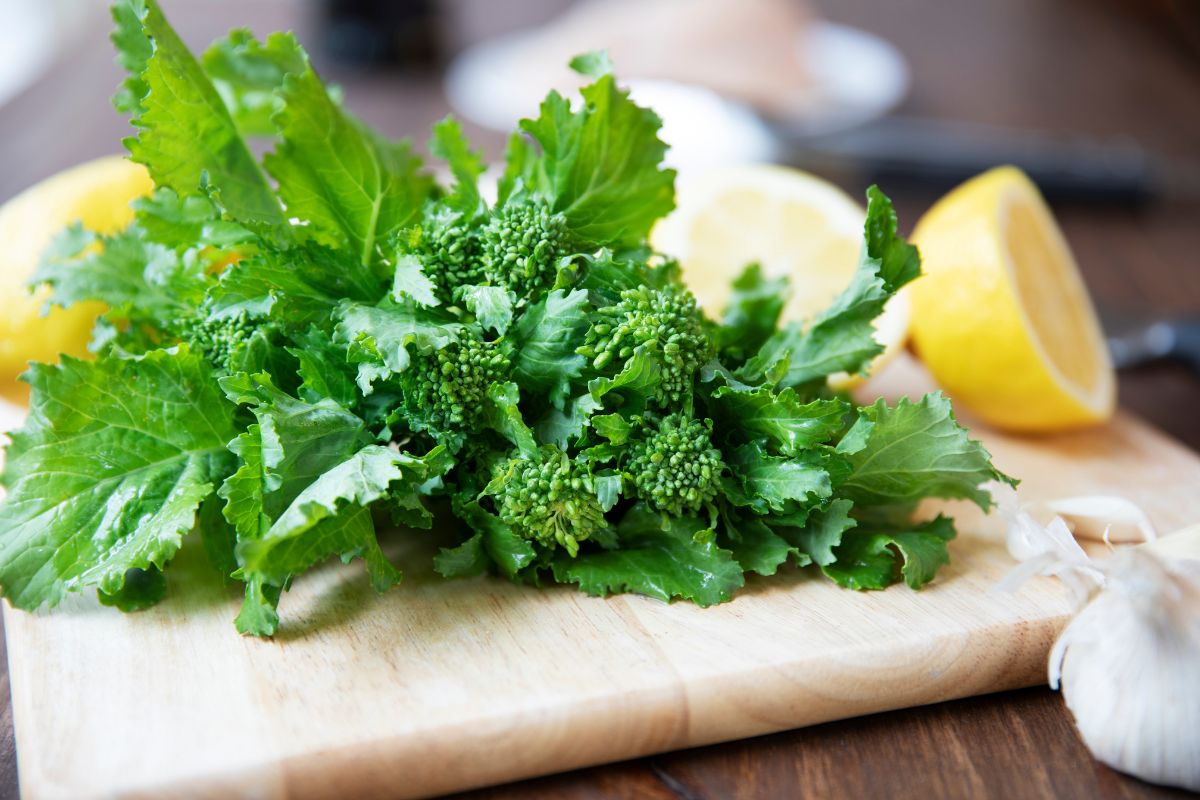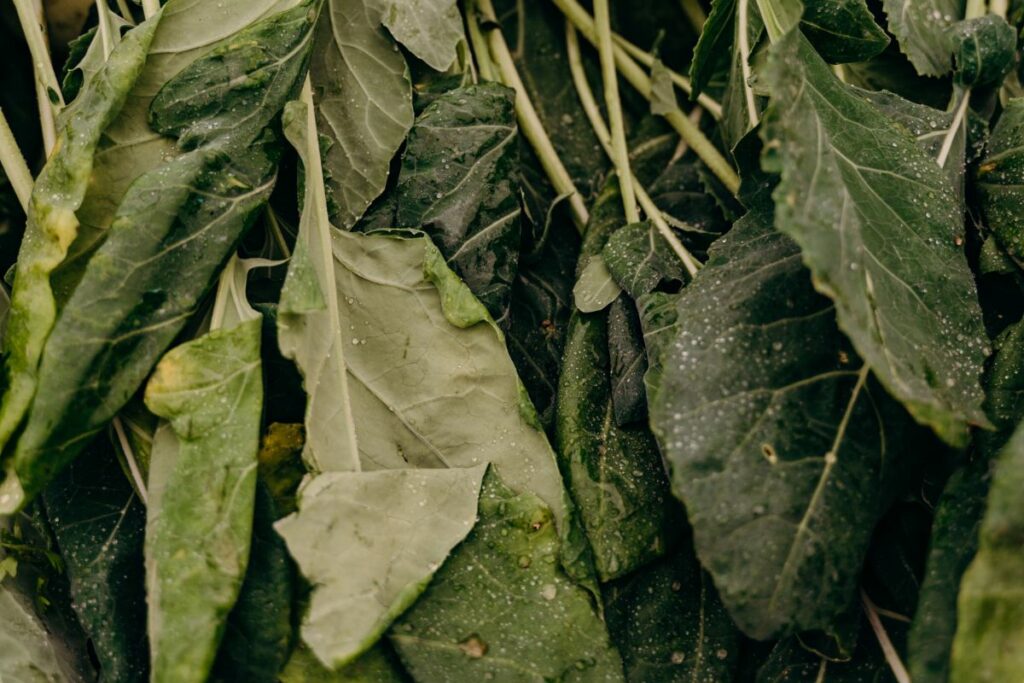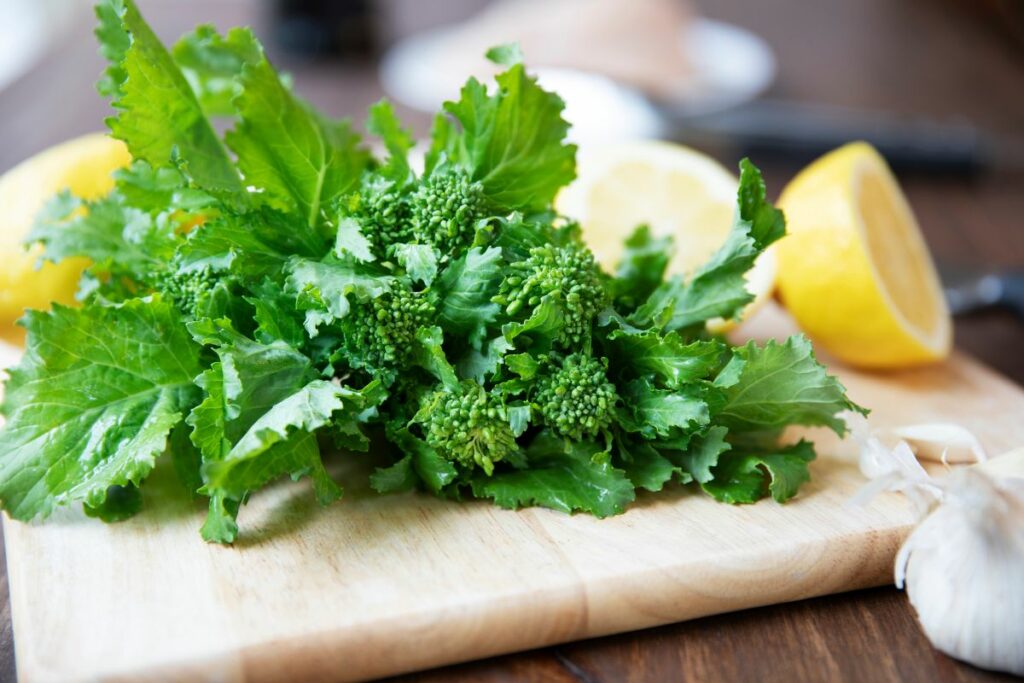Rapini, also known as broccoli rabe, is a leafy green vegetable that is popular in Italian cuisine. It has a slightly bitter taste and is often used in pasta dishes, soups, and stews. However, it can be difficult to find in some areas, or it may not be to everyone’s liking. In such cases, a substitute for rapini can be used.
There are several vegetables that can be used as a substitute for rapini, including mustard greens, turnip greens, collard greens, Chinese broccoli, endives, dandelion greens, kale, and chicory. These vegetables have a similar taste and texture to rapini, and can be used in the same types of dishes. Mustard greens, for example, have a slightly spicy flavor that can add a unique twist to a dish, while kale is a milder alternative that is packed with nutrients.

Contents
- 1 Understanding Rapini
- 2 Rapini Nutrition Facts
- 3 Common Uses of Rapini
- 4 Rapini Substitutes
- 4.1 Broccoli as a Substitute
- 4.2 Broccolini as a Substitute
- 4.3 Chinese Broccoli as a Substitute
- 4.4 Mustard Greens as a Substitute
- 4.5 Collard Greens as a Substitute
- 4.6 Spinach as a Substitute
- 4.7 Kale as a Substitute
- 4.8 Bok Choy as a Substitute
- 4.9 Turnip Greens as a Substitute
- 4.10 Dandelion Greens as a Substitute
- 4.11 Chicory as a Substitute
- 4.12 Asparagus as a Substitute
- 4.13 Escarole as a Substitute
- 4.14 Endives as a Substitute
- 4.15 Chard Greens as a Substitute
- 5 Shopping for Rapini Substitutes
- 6 Preparing Rapini Substitutes
- 7 Health Benefits of Rapini Substitutes
Understanding Rapini
Rapini, also known as broccoli rabe, is a vegetable that is commonly used in Italian and Italian-American cuisine. It is a member of the Brassica family, which also includes broccoli, cauliflower, and kale. Rapini has a distinctive bitter flavor that is often described as strong and pungent.
Origins of Rapini
Rapini is believed to have originated in the Mediterranean region, specifically in Italy. It has been cultivated in Italy for centuries, and is now grown in many other parts of the world, including the United States.
Rapini Flavor Profile
Rapini has a bitter flavor that can be quite strong. The bitterness is due to the presence of compounds called glucosinolates, which are also found in other members of the Brassica family. Despite its bitterness, rapini is a versatile vegetable that can be used in a variety of dishes.
When cooking with rapini, it is important to blanch it first to remove some of the bitterness. This can be done by boiling the rapini in salted water for a few minutes, then draining it and rinsing it with cold water.
Overall, rapini is a flavorful and nutritious vegetable that can be a great addition to many different dishes. Whether you are looking to add some bitterness to a soup or stew, or simply want to enjoy its unique flavor on its own, rapini is definitely worth trying out.
Rapini Nutrition Facts
Rapini is a cruciferous vegetable that is packed with essential vitamins and minerals. It is low in calories and high in fiber, making it an excellent choice for those looking to maintain a healthy diet. In this section, we will take a closer look at the nutrition facts of rapini.
Vitamins in Rapini
Rapini is an excellent source of vitamins, particularly vitamins C and K. One cup of cooked rapini contains approximately 135% of the daily recommended value of vitamin C and 190% of the daily recommended value of vitamin K. Vitamin C is a powerful antioxidant that helps to boost the immune system, while vitamin K is essential for healthy bones and blood clotting.
Rapini is also a good source of folate, which is important for cell growth and development. One cup of cooked rapini contains approximately 25% of the daily recommended value of folate.

Minerals in Rapini
In addition to vitamins, rapini is also rich in minerals such as calcium, potassium, and magnesium. Calcium is essential for strong bones and teeth, while potassium helps to regulate blood pressure and maintain healthy heart function. Magnesium is important for muscle and nerve function, as well as energy production.
One cup of cooked rapini contains approximately 15% of the daily recommended value of calcium, 10% of the daily recommended value of potassium, and 6% of the daily recommended value of magnesium. Rapini is also a good source of iron, with one cup containing approximately 12% of the daily recommended value.
In conclusion, rapini is a highly nutritious vegetable that is rich in vitamins, minerals, and fiber. It is a great addition to any healthy diet and can be enjoyed in a variety of dishes.
Common Uses of Rapini
Rapini, also known as broccoli rabe, is a popular vegetable in Italian and Mediterranean cuisines. It is a member of the Brassica family and has a slightly bitter taste that pairs well with many flavors. Rapini is a versatile vegetable that can be used in various dishes and cooking methods.
Rapini in Italian Cuisine
In Italian cuisine, rapini is a staple ingredient in many dishes. It is often sautéed with garlic and olive oil and served as a side dish. It is also commonly used in pasta dishes, such as orecchiette with rapini and sausage. Rapini can also be used as a topping for pizza or mixed into a frittata.
Rapini in Mediterranean Cuisine
In Mediterranean cuisine, rapini is often used in a similar way to Italian cuisine. It is commonly sautéed with garlic and lemon and served as a side dish. It can also be used in stir-fries with other vegetables and meats. One popular dish is rapini with oyster sauce, which is a savory and flavorful way to prepare the vegetable.
Rapini can also be steamed, boiled, or roasted and served as a side dish with crusty bread. It is a great addition to stir-fries and pairs well with sausage and other meats. Its slightly bitter taste can balance out rich and savory flavors.
In conclusion, rapini is a versatile vegetable that can be used in many dishes and cooking methods. Its slightly bitter taste and nutritional benefits make it a popular ingredient in Italian and Mediterranean cuisines.

Rapini Substitutes
Rapini, also known as broccoli rabe, is a popular vegetable in Italian cuisine. It has a slightly bitter taste and is often used in pasta dishes, soups, and sautés. However, if you can’t find rapini at your local grocery store, there are many substitutes you can use instead. Here are some of the best rapini substitutes:
Broccoli as a Substitute
Broccoli is a close relative of rapini, and it has a similar taste and texture. If you can’t find rapini, broccoli is a great substitute. You can use it in any recipe that calls for rapini.
Broccolini as a Substitute
Broccolini is another vegetable that is similar to rapini. It has a slightly milder taste and is often used in stir-fries and salads. If you can’t find rapini, broccolini is a great substitute.
Chinese Broccoli as a Substitute
Chinese broccoli, also known as gai lan, is a leafy green vegetable that is commonly used in Chinese cuisine. It has a slightly bitter taste and is often used in stir-fries and soups. If you can’t find rapini, Chinese broccoli is a great substitute.
Mustard Greens as a Substitute
Mustard greens are a leafy green vegetable that is often used in Southern cuisine. They have a slightly bitter taste and are often used in salads, soups, and sautés. If you can’t find rapini, mustard greens are a great substitute.
Collard Greens as a Substitute
Collard greens are another leafy green vegetable that is often used in Southern cuisine. They have a slightly bitter taste and are often used in salads, soups, and sautés. If you can’t find rapini, collard greens are a great substitute.

Spinach as a Substitute
Spinach is a leafy green vegetable that is often used in salads and sautés. It has a mild taste and is a great source of vitamins and minerals. If you can’t find rapini, spinach is a great substitute.
Kale as a Substitute
Kale is a leafy green vegetable that is often used in salads and sautés. It has a slightly bitter taste and is a great source of vitamins and minerals. If you can’t find rapini, kale is a great substitute.
Bok Choy as a Substitute
Bok choy is a leafy green vegetable that is commonly used in Chinese cuisine. It has a slightly sweet taste and is often used in stir-fries and soups. If you can’t find rapini, bok choy is a great substitute.
Turnip Greens as a Substitute
Turnip greens are a leafy green vegetable that is often used in Southern cuisine. They have a slightly bitter taste and are often used in salads, soups, and sautés. If you can’t find rapini, turnip greens are a great substitute.
Dandelion Greens as a Substitute
Dandelion greens are a leafy green vegetable that is often used in salads and sautés. They have a slightly bitter taste and are a great source of vitamins and minerals. If you can’t find rapini, dandelion greens are a great substitute.
Chicory as a Substitute
Chicory is a leafy green vegetable that is often used in salads and sautés. It has a slightly bitter taste and is a great source of vitamins and minerals. If you can’t find rapini, chicory is a great substitute.

Asparagus as a Substitute
Asparagus is a vegetable that is often used in salads and sautés. It has a slightly sweet taste and is a great source of vitamins and minerals. If you can’t find rapini, asparagus is a great substitute.
Escarole as a Substitute
Escarole is a leafy green vegetable that is often used in salads and soups. It has a slightly bitter taste and is a great source of vitamins and minerals. If you can’t find rapini, escarole is a great substitute.
Endives as a Substitute
Endives are a leafy green vegetable that is often used in salads and sautés. They have a slightly bitter taste and are a great source of vitamins and minerals. If you can’t find rapini, endives are a great substitute.
Chard Greens as a Substitute
Chard greens are a leafy green vegetable that is often used in salads and sautés. They have a slightly bitter taste and are a great source of vitamins and minerals. If you can’t find rapini, chard greens are a great substitute.
Shopping for Rapini Substitutes
When shopping for rapini substitutes, it is important to keep in mind the flavor and texture that you are looking for in your recipe. Here are some tips to help you find the best substitutes:
Visit Your Local Grocery Store or Supermarket
Most grocery stores and supermarkets carry a variety of leafy greens and green vegetables that can be used as rapini substitutes. Look for vegetables such as mustard greens, collard greens, kale, and spinach. These vegetables are usually located in the produce section of the store.

Choose Vegetables with a Similar Flavor Profile
When choosing a rapini substitute, it is important to consider the flavor profile of the vegetable. Vegetables such as mustard greens, collard greens, and kale have a similar bitter taste to rapini, while spinach has a milder flavor.
Consider the Texture of the Vegetable
Rapini has a slightly crunchy texture, so when choosing a substitute, it is important to consider the texture of the vegetable. Vegetables such as mustard greens and collard greens have a similar texture to rapini, while spinach has a softer texture.
Look for Pre-Packaged Alternatives
If you are having trouble finding rapini substitutes at your local grocery store or supermarket, consider looking for pre-packaged alternatives. Many companies sell pre-packaged greens that can be used as a substitute for rapini.
Try Something New
If you are feeling adventurous, consider trying a new vegetable as a substitute for rapini. Vegetables such as dandelion greens, endive, and escarole have a similar bitter taste to rapini and can be used in a variety of recipes.
Overall, shopping for rapini substitutes can be a fun and exciting experience. With a little bit of creativity and experimentation, you can find the perfect substitute for your recipe.
Preparing Rapini Substitutes
When it comes to preparing rapini substitutes, there are a few things to keep in mind. Whether you’re using mustard greens, collard greens, or any of the other options available, the key is to prepare them in a way that brings out their best qualities. Here are two methods for preparing rapini substitutes that are sure to bring out their delicious flavors.

Blanching Rapini Substitutes
Blanching is a great way to cook rapini substitutes while retaining their bright green color and crisp texture. Here’s how to do it:
Ingredients:
- 1 pound of rapini substitute
- 1 tablespoon of salt
- 4 cups of water
Instructions:
- Bring a large pot of water to a boil.
- Add salt to the water.
- Add the rapini substitute to the boiling water and cook for 2-3 minutes.
- Remove the rapini substitute from the boiling water and immediately transfer it to a bowl of ice water.
- Let the rapini substitute cool in the ice water for 2-3 minutes.
- Drain the rapini substitute and pat it dry with a paper towel.
Sauteing Rapini Substitutes
Sauteing is another great way to cook rapini substitutes. It brings out their natural flavors and makes them tender and delicious. Here’s how to do it:
Ingredients:
- 1 pound of rapini substitute
- 2 tablespoons of olive oil
- 1/2 teaspoon of salt
Instructions:
- Wash the rapini substitute and trim the ends.
- Heat the olive oil in a large skillet over medium-high heat.
- Add the rapini substitute to the skillet and cook for 4-5 minutes, stirring occasionally.
- Add salt to the skillet and continue cooking for another 2-3 minutes.
- Remove the skillet from the heat and serve the rapini substitute hot.
Whether you choose to blanch or saute your rapini substitutes, these methods are sure to bring out their best qualities. Experiment with different cooking techniques and seasonings to find the perfect recipe for your tastes.

Health Benefits of Rapini Substitutes
Rapini substitutes offer a range of health benefits that are similar to those of rapini. Here are some of the key health benefits of rapini substitutes:
Digestive System
Rapini substitutes are an excellent source of fiber, which is essential for maintaining a healthy digestive system. Fiber helps to promote regular bowel movements and prevent constipation. It also helps to keep the digestive system clean and healthy by removing waste and toxins from the body.
Antioxidants
Rapini substitutes are rich in antioxidants, which help to protect the body against damage from free radicals. Free radicals are unstable molecules that can cause damage to cells and contribute to the development of chronic diseases such as cancer, heart disease, and Alzheimer’s disease. Antioxidants help to neutralize free radicals and prevent them from causing damage.
Blood Pressure
Rapini substitutes are also a good source of potassium, which is important for maintaining healthy blood pressure levels. Potassium helps to regulate the balance of fluids in the body and prevent high blood pressure. High blood pressure can lead to a range of health problems, including heart disease, stroke, and kidney damage.
Overall, rapini substitutes are a healthy addition to any diet. They offer a range of health benefits and can be used in a variety of dishes to add flavor and nutrition.
